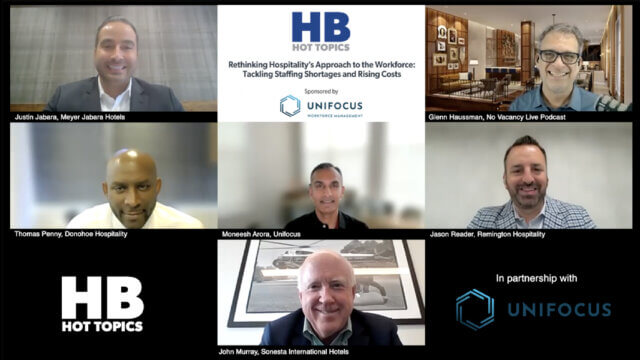Hospitality is an industry of people. Serving guests, bringing smiles to their faces and adding to an enjoyable experience. Extending beyond guests, the industry is one that prides itself on its own people, offering a fruitful place to learn and grow. But what happens when you remove this essential component to what makes the wheels of the industry turn?
The lodging industry has been battling a labor shortage for years, only made worse by a global pandemic. So, how does it tackle a challenge so daunting? Where do we start? The beginning may be a great place, analyzing the roots of a pandemic all of its own.
“I don’t foresee this [labor shortage] improving in the near future, and I think there are two primary reasons; industry exit is one of them,” said Ron Loman, SVP, operations, Real Hospitality Group.
Hospitality, without a doubt, lost workers to other industries, but not necessarily similar industries. With online ordering skyrocketing this past year, Loman believes more e-commerce-driven companies like Amazon have lured workers over to their seemingly greener pastures.
“I think associates took the time to search for stability, flexibility and compensation that they felt they should have… Maybe the pandemic gave them the opportunity to do that,” he said.
A large portion of the workforce simply went on unemployment as well, providing that flexibility.
“The second part is this is the perfect storm,” Loman said. “We had to close down; we had a lot of talent that went out, found opportunities and, in that case, hoteliers had a chance to buy up a little bit and got talent from downtown markets or markets willing to come work where compensation was probably a little less. And now, business is bouncing back—and what I would coin as the ‘hospitality shuffle’ is starting to begin. That’s going to be the biggest challenge from a mid-level management aspect in the short-term.”
Studies are estimating about 15-20% of all previous associates will leave the hospitality industry permanently, according to Michael Karicher, EVP, human resources, Remington Hotels.
“We are finding workers are leaving the hospitality and restaurant industries for the warehouse industry or on-demand delivery, where wages and benefit offerings have historically been higher,” Karicher said.
But it’s important to remember that other issues contributing to the shortage that were in place pre-pandemic remain today.
“Labor availability has been challenged in recent years [pre-pandemic] by low immigration to the U.S. and traditionally low wages for hourly lodging roles that many workers are less desirous to accept,” said Gregory J. Miller, VP, lodging and experiential leisure equity research, Truist Securities, the full-service corporate and investment banking arm of Truist Financial Corporation. “Hotel jobs can be physically hard, have odd hours and can require a lot of service-with-a-smile excellence—which is not a great fit for every worker.”
Post-pandemic, Miller believes labor issues have changed somewhat—aside from those previously mentioned—to now include issues related to children’s virtual schooling that conflicts with work schedules; fear of getting sick from coworkers and guests; in some markets, reduced public transportation; and a hostile work environment from guests who are anti-mask/anti-vaccine and take out their anger on hourly guest-facing staff trying to enforce health/safety protocols or government restrictions.
Employee expectations have also changed with an increased focus on flexibility and job security.
“I think job security is key,” Miller said. “From the housekeeper to the white-collar headquarters professional who may have been career loyalists with the same employer for decades, COVID effectively presented how fragile a job in the lodging industry can be in a pandemic. Part of the issue on rehiring today is: Is there a real risk I am furloughed or laid off again? I think the lodging industry risks versus more stable industries is a real and ongoing threat and will not quickly be forgotten by those who struggled to find employment in the last 15 months.”
The roots of the issue surely matter, and how these challenges have evolved certainly do, but the industry focus is shifting from “Why has this happened?” to “How do you bring back top workers while recruiting loyal talent?” If the answer was clear, this wouldn’t be the industry’s number-one challenge, but there are some logical paths to at least easing the sting.
Loman suggests first identifying top talent, which the pandemic made a bit easier. “Those associates and managers who were cross-trained during the pandemic, they were like gold,” he said. “If I had a person who could run F&B and do orders, yet also knew how to check someone in and could answer the phone and make a reservation—wow.”
Karicher recommends considering new candidates with these crossover skills to the industry as well. “We cannot count only on those who have only worked in hospitality as the only viable candidates for the job. Be committed to training new staff in the industry and provide a path for growth,” he said.
Remington has been building its apprentice programs and promoting talent from within the organization whenever it can. Through recently implemented sign-on bonuses and referral bonuses in the field, the company is also incentivizing employees and demonstrating examples of growth opportunities in the hospitality industry.
“We need to continue to show that we provide good career paths in our industry and that it is a rewarding career on many levels. After all, we do say, ‘Come for the job, stay for the career,’” Karicher said.
Real Hospitality has looked at its mentoring program as well, which builds various competencies by exposing associates to every department. Loman believes that companies can build bench strength this way and, in turn, create even more flexibility for workers.
Miller noted that hoteliers should also work to differentiate between hourly workers, property management and above property/corporate-level roles.
“For the property manager-level roles, the ‘good problem’ is that hotel workers trained in excellent customer service, strong operating standards and other facets of effective hospitality are skills that have value in organizations not necessarily viewed in an equivalent service-focused light,” Miller said. “Our industry offers great talent where excellence in service is trained and ingrained from day one. Beyond that, when we speak with owners and operators, we often hear how difficult it is to replace a good manager and that some will leave a role for simply a few thousand dollars of additional salary. So, part of the issue is how much hoteliers are willing to spend to pay up. And, in today’s landscape where property managers are performing housekeeping and front desk tasks on top of their normal job at exhausting paces and hours, the burnout factor is real.”
According to Miller, if a recruiting hotel can offer a better salary or better work conditions, or if an industry outside of hospitality is recruiting for a sales role or property engineer, there could be a strong rationale today to exit the hotel industry.
“Brand or operator loyalty is not immaterial, but in today’s environment, perhaps it’s less of a factor,” Miller said.
For Spire Hospitality, retaining talent is top of mind. The company has implemented a more robust recruiting/retention bonus and is also offering more flexible schedules.
“In several markets, we have restructured wages, including seasonal wages, shift differentials and phased increases,” said Dawna Comeaux, SVP/COO, Spire Hospitality. “We are targeting colleges and universities for seasonal support this summer in some of our resort locations. Additionally, we continue to cross-share when we have high needs in specific areas, which has been a great way for some of our team members to get exposure to other brands, as well as travel and work in a new market. We are finding that we have to understand each market and what might work in one, might not in another.”
Incentives have been a way to retain talent, but possibly a smart way for hoteliers to save on costs long-term is to offer one-time incentives, Miller said, such as a signing bonus if someone stays ‘x’ number of months.
“Raising wages sets a new bar that is unlikely to be lowered if labor conditions change,” Miller said. “That said, raising wages may be an inevitability today for many hoteliers. Other incentives that gather less attention but are relevant especially for lower-paid workers include food credits/free meals, transportation credits or assistance in getting to work, English-language training and other non-monetary benefits that are meaningful.”
Miller added that healthcare costs, while significant and growing, are important if not essential to hourly employees who lack safety nets and work physical jobs.
“Creating better wellness for employees and their families is an opportunity at the hourly level—and I do not refer to having hourly staff in their uniforms being pictured working out on treadmills,” Miller said. “Real wellness includes ensuring that employees are in excellent physical, emotional and financial health to conduct their jobs effectively. The hotel industry has some scale benefits to work on these matters perhaps with less incremental costs than raising hourly wages to compete head-on for jobs in other industries that may pay better but have less pleasant work conditions, such as some distribution centers, healthcare facilities and warehouses.”
Additional incentives may include certifications through AHLA, HSAMI, among other hospitality associations, Loman said, which he believes offer an unmatched sense of achievement.
“Those [certifications] are all milestones that our mid-level managers collect,” Loman said. “Often, they don’t collect them because there’s a financial part of it, but bringing those into the workplace are critical mostly for the associate. I remember when I did classes and got involved, it was a big deal when you got a certification. A lot of our folks may not have had that extended education of four years of college.”
Undoubtedly, how to solve these labor woes doesn’t have a single answer and surely won’t be accomplished in the near future. However, it seems that identifying and training for hospitality talent while also providing smart incentives is a good place to start.
“There are not going to be easy answers that will have broad, consensus appeal and some markets and hotels have unique issues,” Miller said. “I would also argue that it behooves the industry leaders to remind those in Washington that just because they represent a small town or rural area that labor issues in a big city, even in a different state, are still relevant. If an industrial manufacturer or farmer does not attend a trade show because of labor issues in a different city or state, or if business travel isn’t conducted because hotels are unappealing due to labor/operating constraints, eventually that impact flows across cities and states. I feel like the message of ‘we are all in this together’ is sometimes missed.”
Moving forward, Miller advises hoteliers to better message the appeal of hotels versus alternative accommodations and differentiate itself as an industry based on service, loyalty programs, cleanliness standards, on-site amenities and business functionality for bleisure and “work from anywhere.”
“Perhaps focusing on the basics of why the hotel industry is and should be a better place to work than say a distribution center is not messaged well enough to government leaders and to a greater potential workforce,” Miller said. “We pat ourselves on the back within the industry but I’m not sure if most Americans are so aware of the unusual positives of a career in hospitality. How many other industries do you see employees genuinely smiling in their jobs or taking vacations with great employee discounts? Not many.”

